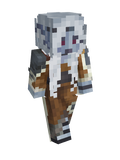Alathra:Elves
| Elf | |
|---|---|
| Major race | |
 Example appearance | |
| Characteristics | |
| Average lifespan (max) | 400 years (800) |
| Height range | 1.75 - 2.10 m (5′9′′ - 6′10′′) |
| Strengths | Natural grace and perception; skills in archery, subtle magic, artistry, and nature lore. |
| Weaknesses | Physically delicate; emotionally aloof; slow to change or adapt to new cultures. |
| Back to Major races → | |
Elves are a tall, long-lived race known for their ethereal appearance, deep magical affinity, and cultural dedication to grace, art, and tradition. Similar to Florans, they are unique in their symbiotic relationship with nature. Taller and more graceful than most other sapient species, they are often perceived as aloof or slow to act. In truth, elves are one of the most calculated and forward-thinking races in the world of Alathra, often moving on timelines too long for others to notice.
They are quiet architects of civilization, shaping the world not through brute strength or power, but through the slow, deliberate planting of ideas and systematic thought. Elves hold value in things of elegance, forethought, and a commitment to making a legacy. They see steam-powered machinery, rapid industrial expansion, and carbon-fueled innovation as short-sighted. Useful perhaps, but dangerous when driven by short-lived minds.
Elven societies are typically ancient, heavily layered in ritual, and meticulously maintained. Education is lifelong. A young elf of 100 might still be considered a novice scholar or composer. Their love of art, language, and mathematics has made elven scholarship the foundation of many non-elven institutions.
Strengths and weaknesses
Elves are, above all, a race of patience and precision. Their long lives grant them a unique perspective on time and its relation to a civilization's progress. While other races may rush to invention or conquest, elves tend to shape the world slowly and deliberately. This manifests in their strength as architects of culture: many languages, legal structures, and magical schools trace their roots back to elven authorship, often without those using them being fully aware of that being the case.
Their natural affinity for magic does not erupt in bursts of power but settles into quiet mastery. Elves are particularly skilled in long-form or passive magics; techniques that require careful calibration rather than brute force. Similarly, their art and craftsmanship reflect this focus: an elven sculpture or song might be as much a magical device as a work of beauty, its effects unfolding only to the patient or the wise.
On the other hand, the elves’ gift for long-term vision can make them painfully slow to respond to an immediate crisis. Where humans or orcs might act within minutes, an elven council may still be debating the moral implications of intervention. This tendency to delay action, born from centuries of habit and cultural consensus, can render them ineffective in fast-moving or high-stakes situations. Their pride in tradition, while a source of cultural strength, also breeds a form of cultural arrogance. Many elves, particularly of old age, regard the innovations of younger races as shortsighted, even dangerous. This can strain diplomatic relations, as well-meaning guidance from an elf may be perceived by others as condescension or veiled control.
Additionally, elves are not well suited to dramatic upheaval. Their societies are deeply rooted in structure, ecology, and slow growth. When confronted with rapid industrial expansion, deforestation, or chaotic war, elven communities can become paralyzed, fractured, or retreat into isolation. Even their decentralized systems of governance, which favor autonomy and regional tradition, can become a weakness when unity is required. Elven lands are rarely unified under a single banner, and coordinated action between cities or enclaves often takes years of diplomatic weaving.
Elves excel when given time, stability, and influence through soft power. But in an age of roaring engines and rapid change, their greatest strengths are often challenged by a world that no longer moves at their pace.
Minor races
Wood Elves
Average lifespan: 400 years
Height range: 1.67 - 2.10 meters
Veyari
Average lifespan: 250 years
Height range: 1.5 - 2 meters
Dryad
Average lifespan: 400 years
Height range: 1.5 - 1.9 meters
Ash Elves
Average lifespan: 400 years
Height range: 1.75 - 2.20 meters
The Faenari
Average lifespan: 400 years
Height range: 1.6 - 2.1 meters
The Faenari are elemental and elusive, deeply attuned to one of the four natural elements; earth, air, fire, or water. Though similar in form to elves, their bodies reflect their elemental heritage, from bark-like skin or glacial eyes to ember-glow hair and storm-cut wings. Bound by ancient tradition and elemental worship, each clan is shaped by its environment, their magic potent but narrow, able to wield only their native element, and even then at a cost to mind and spirit. Clever, unpredictable, and have a strong resistance to their chosen element, Faenari are both revered and distrusted across the world.